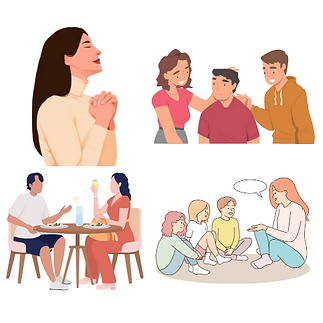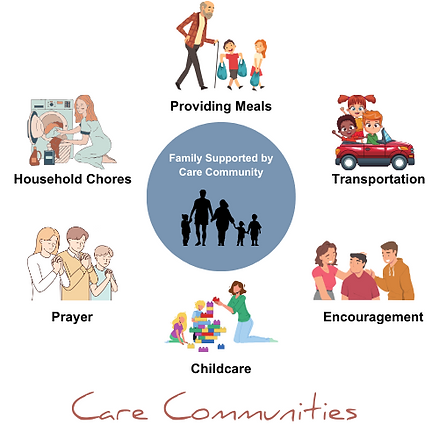This is the final installment of our three-part Hope and Homes blog series on West Virginia’s foster care challenges, why the Church should be engaged in the issues, and how churches can impact vulnerable children and families practically and meaningfully.
In part one of the Hope and Home series, “West Virginia Children and Families Are Suffering”, we delved into why West Virginia’s foster and kinship care situation is concerning. The state has one of the highest per capita rates of children in foster care, with nearly three times the national average removed due to maltreatment. It also removes children from homes at almost five times the national rate. Many children live in homes led by grandparents or relatives, often due to parental substance abuse. These foster experiences lead to long-term emotional and mental challenges for the children.

In part two, titled “When Children Are Suffering, The Church’s Required Response is Clear,” The Village explored the Church’s role in addressing the challenges faced by foster children. Scriptures emphasize God’s deep concern for vulnerable children and underline the church’s duty to protect and support them. Followers of Christ are encouraged to reflect his love and care, especially for the marginalized. The church, a collective of diverse individuals with distinct gifts, is ideally positioned to provide a nurturing environment for fostering families, kinship, adoptive families, and other vulnerable children and families.
The Question of How to Care
Once churches understand the issues in the Mountain State’s foster care system and reflect on why churches should care for vulnerable children and families, we find that they immediately begin to wonder HOW to become engaged. Churches are often full of people who would love to get involved in the system but do not know where to start.
The purpose of this final post in this series is to show churches how they can become part of the solution to the issues faced by vulnerable children and families in their communities. Let’s start by looking at who can help!
An “Everyone Can Do Something” Philosophy
In many cases, churches engaged in foster care have primarily focused on recruiting foster and adoptive families, a mission epitomized by programs such as “One Church, One Child.” This effort had the singular goal of finding one family in every church across the state to adopt a child.
While the initiative has seen success, it tended to overlook the wider congregation who could not foster or adopt but still harbored a desire to help. This is where the “Everyone Can Do Something” philosophy, detailed extensively in Jason Johnson’s seminal field guide, comes into play.
Drawing from the vivid imagery of 1 Corinthians 12:14-27, it likens the Church to a human body in which every part has a vital role.
“For the body does not consist of one member but of many… God arranged the members in the body, each one of them, as he chose.”
This analogy lays the foundation for the idea that every individual harbors the potential to contribute through prayer, financial aid, or tangible acts of service.

Furthermore, guided by Romans 12:6-8, this philosophy recognizes the diverse spiritual gifts endowed upon the members of the Body of Christ.
“We have different gifts, according to the grace given to each of us.”
Whether through leadership, teaching, administration, or other forms of service, every individual can leverage their unique gifts to play a pivotal role in the upliftment of the vulnerable.
Moreover, embracing Galatians 6:2 — “Carry each other’s burdens, and in this way, you will fulfill the law of Christ” — the philosophy encourages members to support one another, fostering a culture of mutual aid and inclusivity, further steering away from a sole focus on recruitment to nurturing a community where everyone is empowered to make a meaningful contribution.
This shift towards an inclusive culture reiterates that every gesture carries significant value, no matter its scale. The goal is to foster a Church community where support for the vulnerable is ingrained in its very identity.
Where Should a Church Focus?
Once a church begins to understand and embrace the idea that everyone can do something, the next step becomes precisely what to do. This decision is threefold. Where along the spectrum of child welfare should the church focus, where should the church focus geographically, and, finally, where should the church focus in terms of the types of activities it conducts to help vulnerable children and families.
Where on the Child Welfare Spectrum: Finding a Place Along the River
Jason Johnson presents a helpful analogy in “Everyone Can Do Something.” Imagine a rapidly moving river. Standing on the riverbank are three friends. In this stream are dozens and dozens of children that are being swept downstream. These children are in immense peril and danger of drowning. Although each of these friends sees the same events, their reactions are distinctly different.
The first friend dives into the stream directly before him and pulls the children out of the river. This mid-stream rescue is analogous to churches traditionally involved in foster care and adoption, where they help children who have been removed from homes.
The next friend hurries downstream to see what is happening to those children swept further down the river. These children are nearing a waterfall as this friend pulls them to safety. These downstream rescues are analogous to churches devoted to efforts caring for aging-out foster youth, ministering to the homeless, or assisting the incarcerated.

The third friend chooses to sprint upstream. He learns why they are falling into the water in the first place, and he pulls them out before they are swept over the waterfall. These upstream efforts can be compared to churches that work to help struggling biological and primary families and those children who may be in danger of removal from their family homes.
Yet, for churches, it isn’t about being everywhere or diluting efforts across the river’s entirety. Instead, the crux lies in identifying that particular stretch of the river where their passion resonates most strongly and where they can deploy their resources. Not every church is called to the same mission.
Where in the World: Shrinking the Problem and Making It Local
Once you have found your place in the river, now you have to make it local. As we’ve covered in previous discussions, West Virginia has the largest per capita rate of children in foster care in the United States. With over 6,000 children in care and 40,000 being primarily cared for by kinship caregivers, the numbers are staggering and overwhelming.
However, when the local church becomes engaged in caring for vulnerable children and families, that church is not responsible for each child across the entire state. However, it can be responsible for those children in its own community.
As an example, let’s imagine a small church in Buckhannon, WV. One church could quickly become disillusioned if it focuses on trying to care for all 6,000+ kids in care across the state. However, it could focus on the 67 Upshur County children in care at that point in time. Furthermore, 46 of those children are in kinship care. Assuming 2 children in each kinship home, that amounts to 23 kinship families caring for those children.

Supporting 23 kinship families is something that even a local, small church can work on solving. This is also an important activity because these families are often overwhelmed, isolated, and struggling. Furthermore, if these kinship families become unable to care for these children – then they go into traditional foster care. Keeping kinship families healthy and serving is an incredibly important mission.
In the average West Virginia church, there are substantial odds that there is, at least, one family within its congregants that is caring for a grandchild or a foster child. That family, or those few families already in the church, are the most immediate concern of this local church. Consider if this one small church supports just two families caring for grandchildren – that is nearly 10% of the families in the county who are caring for grandchildren!!
According to the Association of Religion Data Achieves, there were 65 congregations in Upshur County in 2020. It is completely possible for each and every kinship family in the 67 children counted to receive support from a local church.
Where Inside the Church: Integrating Orphan Care into Church Activities
Now that you have your place in the river within the community, what is the next step? You do not have to recreate the wheel. One can begin the work in areas where the church’s heart and passions of its people already lie. In many churches, structures already exist that can be harnessed to advance foster, adoptive, kinship, and vulnerable children and family care. Instead of viewing such care as a specialized, separate domain, it should be integrated into a church’s core activities. For example, if you meet in small groups, create a group around foster care that aligns with the church’s identity. Similarly, leveraging established events and services, such as parent/child dedication or counseling, to focus on foster care can organically amplify the cause.
Family Advocacy Ministries (FAMs):
Meeting Needs through FAMs
As churches begin to embrace new philosophies of caring for vulnerable children and families, they can start to consider the specific methods and models to deploy.
Chestnut Mountain Village guides and equips churches to build Family Advocacy Ministries (FAMs). These ministries are structured ministries designed for churches to actively support and advocate for vulnerable children and families. FAMs are a proven, simplified, step-by-step ministry model that amplifies the Gospel, encourages spiritual progress, and involves the entire church.
While every FAM will be different, each will meet the needs of children in the system. The categories of needs that can be met by Family Advocacy Ministry activities include:
- Practical and Physical Needs;
- Emotional and Social Needs; and
- Educational and Navigational Needs.
FAM Activities: The Multiple Ways that FAMs Can Help
Within each category, there are many activities that a FAM can engage in. Examples of activities within each of these categories are as follows:
Practical and Physical Needs: These activities provide tangible necessities and resources for daily living and well-being (food, clothing, shelter, ECT).
- Providing Meals: Setting up schedules for church members to provide meals to new foster/adoptive families.
- Donation Drives and Foster Closets: Organizing collections of essential items such as clothing, school supplies, and toiletries for families.
- Transportation Assistance: Organizing volunteer drivers to assist families with transport needs.

- Lawncare Assistance: Providing help with simple lawncare and gardening activities.
- Household Chore Assistance: Helping families with simple items like laundry, basic home repairs, and cleaning to lighten the load.
- Occasional Financial Assistance: Assisting with well-defined financial needs such as emergency situations.
- A Myriad of Other Activities: Helping with practical and physical needs can include other activities as varied as automobile maintenance and repair, furniture moving, painting, and countless other activities.
Emotional and Social Needs: These activities address the families’ psychological and interpersonal aspects of well-being, encompassing feelings, relationships, social interactions, and a sense of belonging.
- Encouragement and Prayer: Sending regular texts and making calls or visits to encourage those in the system. Organizing prayer teams to take prayer requests and pray for the families and children.
- Support Groups: Hosting or facilitating support group meetings for foster, adoptive, and kinship parents within the church community.
- Parent Mentoring Programs: Pairing experienced foster/adoptive families with those new to the process.
- Date and Free Nights: Organizing evenings where church volunteers care for children, allowing parents or caregivers a night off.

- Childcare and Respite Care: Providing occasional short-term child care or organizing respite care for longer-term childcare needs.
- Family Events: Organizing social gatherings or outings catering to foster, adoptive, and kinship families.
- Mentoring Children: Mentoring means to simply establish meaningful relationships and spend time with youth in simple activities like getting ice cream, going to the movies, riding bicycles, etc.
Educational and Navigational Needs: Providing the guidance, training, and information necessary to understand, adapt to, and navigate various systems, processes, and challenges in life.
- Training Workshops: Offering workshops on topics relevant to fostering, adoption, or kinship care, like trauma-informed care, navigating the school system, or understanding legal rights.
- Navigational Assistance: Offering guidance in liaising with child welfare, understanding legalities, or finding relevant community services.
- Advocacy and Awareness Events: Organizing events or campaigns to raise awareness about the needs and challenges of those in the system.
- Life Skills Training: Working with children and families to improve their skills in managing personal finances, cooking, or maintaining healthy habits.
- Tutoring for Students: Helping foster, adoptive, kinship, or other vulnerable children with help in specific topics or courses in which they struggle.
Addressing Multiple Needs Through Care Communities
One of the organizing activities that a FAM can deliver is Care Communities. Care Communities are organized groups that efficiently provide various support activities to foster, adoptive, kinship, and vulnerable families. Through this structure, they effectively address multiple needs.
Care Communities operating within Family Advocacy Ministries (FAMs) framework have significantly addressed the pressing needs of those in the system. With alarming statistics showing that 50% of foster families quit within their first year and 80% discontinue by the second year, the introduction of Care Communities has been transformative.
When enveloped by the support of a FAM that includes these Care Communities, a remarkable 90% of foster families continue into their second year. By serving multiple categories of needs—practical and physical, emotional and social, and educational and navigational—these communities offer a holistic approach to assistance.

In states grappling with a high demand for foster homes, like West Virginia, the role of Care Communities is paramount. Facilitated by churches and mentored by organizations such as Chestnut Mountain Village, Care Communities are groups of dedicated church volunteers.
The transformative influence of Care Communities is evident not only in statistics but in the very fabric of the families they support. These communities have proven invaluable in places like West Virginia, with a disproportionate number of children in foster care or kinship arrangements. They create an ecosystem where families find rest, understanding, and camaraderie.
Care Communities follow a tried-and-tested, adaptable model, allowing churches to mold it according to their unique mission and vision. By mobilizing volunteers, they ensure a broad spectrum of support.
Building Strong FAMs: Leadership, Sustainability, and Community
Launching a Family Advocacy Ministry (FAM) within a church setting requires careful consideration and a deep understanding of key principles. As churches embark on this transformative journey, there are essential guidelines to embrace.
Leadership: Establishing leadership early in forming FAMs is foundational. Strong leadership sets the direction and vision for the ministry and acts as a catalyst for growth.
When establishing leadership for a FAM, a strong leader must have ownership of the ministry. Church pastors, while instrumental in endorsing the FAM initiative, are often occupied with numerous other responsibilities. Instead, the torch is passed to “Advocates.” In essence, Advocates are passionate volunteers who champion FAMs ways in their church.
Slow and Sustainable: Sustainability stands at the core of a successful FAM. Churches are encouraged to start with a narrow focus, mastering a few select activities before considering broader outreach. By emphasizing quality over quantity, FAMs can ensure they provide the highest level of care.
Community and People Before Ministry and Process: The essence of FAMs lies in the strength of its community and relationships. While structures, processes, and strategies are essential, they must always be secondary to the people involved.
Transforming Foster Care:
A Collaborative Vision of Abundance
For generations, the foster care system has been burdened by a narrative of “not enough”: not enough resources, not enough homes, and not enough support. However, what if communities, inspired by teachings from scriptures and contemporary collaborative principles, could pivot from scarcity to one of abundance?
To do this in our modern context, the transformation of the foster care system beckons a broad and united front. Churches bring moral and spiritual anchoring, Non-profit organizations can offer specialized services and resources, businesses can provide financial backing, and placement agencies, with their intricate knowledge of the system, can work closely with governmental bodies to implement change.
Central to this collaborative venture are four foundational principles:
- Unifying Direction: Every stakeholder, from churches to businesses, needs to be aligned with a shared vision.
- Broad Participation: The rejuvenation of foster care requires the active participation of varied entities.
- Structural Framework: Beyond intent, there’s an inherent need for robust structures that foster cooperation and trust.
- Following Guided Direction: Strategy and spiritual alignment are paramount. As communities forge ahead, they must remain attuned to spiritual counsel.
Crucially, any successful collaboration hinges on trust. Trust facilitates open dialogue, fosters mutual respect, and accelerates the achievement of goals.

The challenge of reshaping the foster care system is monumental but not insurmountable. Through deliberate collaboration and unwavering trust among different groups, we can shift from a narrative of scarcity to a promising vision of abundance.
Final Word: Hope, Homes, and the Role of the Church in West Virginia
In the conclusion of our “Hope and Homes” series, we stress the imperative role of churches in West Virginia.
Everyone can do something. Whether it be adopting a child, providing respite care, or something as simple as cutting grass, all have a vital role to play.
You do not have to start from the ground, either. You have access to the Family Advocacy Ministries (FAMs), a systematic approach guiding churches in forming Care Communities that offer holistic support to foster and kinship families. Congregational efforts involving various stakeholders — government bodies, businesses, and nonprofits — foster an environment that transcends mere assistance, building resilient support systems.
In this call-to-action, we underline the transformation churches can facilitate, moving from understanding to decisive action. This change orchestrated not just through grand gestures but through everyday acts of kindness. This underscoring the truth — everyone can indeed do something.
For guidance and resources as to how to begin building a FAM in your local church, contact The Village.
Find your something.
